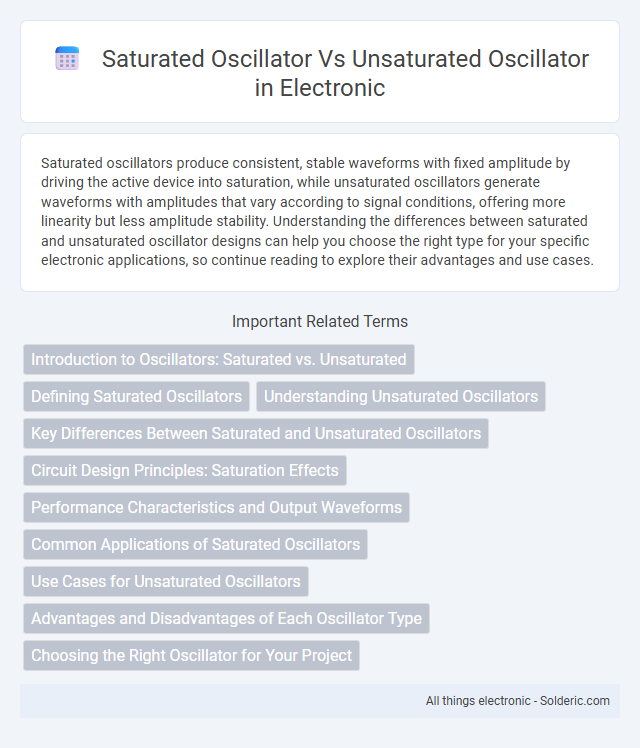Saturated oscillators produce consistent, stable waveforms with fixed amplitude by driving the active device into saturation, while unsaturated oscillators generate waveforms with amplitudes that vary according to signal conditions, offering more linearity but less amplitude stability. Understanding the differences between saturated and unsaturated oscillator designs can help you choose the right type for your specific electronic applications, so continue reading to explore their advantages and use cases.
Comparison Table
| Feature | Saturated Oscillator | Unsaturated Oscillator |
|---|---|---|
| Amplitude Control | Uses nonlinear components to limit amplitude | Amplitude varies without nonlinear limiting |
| Output Signal | Constant amplitude waveform | Amplitude may grow or decay |
| Stability | High stability due to amplitude saturation | Lower stability, amplitude dependent on gain |
| Gain Requirement | Gain adjusted above unity, controlled by saturation | Gain set close to unity to prevent signal distortion |
| Waveform Shape | Usually sinusoidal with low distortion | May show distortion if gain is not optimized |
| Typical Applications | Frequency generators, precise signal sources | Experimental and low-stability oscillators |
Introduction to Oscillators: Saturated vs. Unsaturated
Saturated oscillators operate with active devices driven into full on-off switching, generating stable, large-amplitude signals ideal for digital clocks and square waves. Unsaturated oscillators maintain active devices in their linear region, producing sinusoidal outputs with lower distortion, preferred in RF communication and signal processing. Understanding whether your application requires the clean sinusoid of an unsaturated oscillator or the robust switching of a saturated oscillator ensures optimal circuit performance.
Defining Saturated Oscillators
Saturated oscillators operate by driving the active device into saturation, producing a stable, large-amplitude oscillation characterized by nonlinear wave shaping that enhances signal stability. In contrast, unsaturated oscillators maintain the active device within its linear region, resulting in lower amplitude signals with less distortion but more sensitivity to parameter variations. This saturation-based approach in saturated oscillators ensures consistent amplitude control and improved waveform purity in applications such as frequency synthesis and signal generation.
Understanding Unsaturated Oscillators
Unsaturated oscillators operate below the nonlinear saturation limit of the active device, ensuring a linear and stable output amplitude with minimal distortion. Unlike saturated oscillators, which rely on nonlinear clipping to maintain consistent amplitude, unsaturated oscillators use linear gain control techniques to prevent signal distortion and phase noise. This results in improved signal purity and better frequency stability, making unsaturated oscillators ideal for high-precision applications such as communication systems and signal processing.
Key Differences Between Saturated and Unsaturated Oscillators
Saturated oscillators operate with their active components driven into full saturation, producing a square or clipped output waveform ideal for digital and switching applications. Unsaturated oscillators maintain their active devices within the linear region, generating sinusoidal outputs used in communication systems and signal processing. The choice between saturated and unsaturated oscillators depends on desired output waveform shape, signal distortion tolerance, and application requirements for frequency stability and spectral purity.
Circuit Design Principles: Saturation Effects
Saturated oscillators operate by driving the active device into nonlinear saturation, producing stable amplitude output due to clipping effects that limit signal growth. Unsaturated oscillators maintain linear operation of the active device, relying on precise gain and feedback balance to sustain oscillations without distortion. Saturation effects in oscillator circuit design provide inherent amplitude stabilization but introduce harmonic distortion, whereas unsaturated designs prioritize signal purity with more complex amplitude control mechanisms.
Performance Characteristics and Output Waveforms
Saturated oscillators produce stable, high-amplitude, and distortion-free output waveforms due to their operation in the non-linear region, which ensures consistent amplitude regardless of input signal strength. Unsaturated oscillators operate in the linear region, resulting in output waveforms with lower amplitude and possible distortion, making them more sensitive to input variations and less stable in maintaining a uniform waveform. Your choice between the two affects the oscillator's performance characteristics, with saturated oscillators offering better amplitude stability and cleaner signal quality for applications requiring precise waveform generation.
Common Applications of Saturated Oscillators
Saturated oscillators are commonly used in digital circuits and waveform generators due to their ability to produce stable, square wave outputs ideal for timing and clock pulse applications. Their robust operation makes them suitable for clock signal generation in microprocessors and digital logic systems where precise frequency control is crucial. You can also find saturated oscillators in applications like pulse width modulation and frequency synthesis, where a consistent amplitude is necessary for reliable performance.
Use Cases for Unsaturated Oscillators
Unsaturated oscillators are ideal for applications requiring stable frequency generation with minimal distortion, such as signal processing, communication systems, and low-noise amplification. Their linear operation preserves waveform integrity, making them suitable for precision instrumentation and audio signal generation. Unlike saturated oscillators, unsaturated types support fine amplitude control, enhancing performance in sensor interfaces and frequency synthesis circuits.
Advantages and Disadvantages of Each Oscillator Type
Saturated oscillators offer high amplitude stability and generate clean, distortion-free signals ideal for precise applications, but they can consume more power and have slower startup times. Unsaturated oscillators provide faster startup and lower power consumption, making them suitable for portable devices, yet they tend to produce signals with more distortion and less amplitude stability. Choosing the right oscillator depends on Your need for signal purity versus efficiency and response time.
Choosing the Right Oscillator for Your Project
Choosing the right oscillator for your project depends on the desired signal stability and amplitude control. Saturated oscillators provide a stable, constant amplitude output ideal for frequency sources in communication systems, while unsaturated oscillators offer linear operation with variable amplitude useful in signal processing and modulation applications. Understanding your project's requirements for signal distortion, power consumption, and amplitude consistency will help determine whether a saturated or unsaturated oscillator best suits your needs.
saturated oscillator vs unsaturated oscillator Infographic

 solderic.com
solderic.com